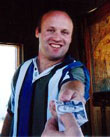|
|
 
|
|
Author
|
Topic: Changable Focal Length??
|
Dave Bird
Jedi Master Film Handler

Posts: 777
From: Perth, Ontario, Canada
Registered: Jun 2000
|
 posted 10-08-2000 10:40 PM
posted 10-08-2000 10:40 PM





Back where I belong tonight (outdoors), we visited a drive-in I looked at buying about a year ago. Spent some time in the booth. He'd taken the Kalee/carbon c/o's out (one's in the snack-bar - nice touch) and installed my own setup - XL with SH-1020 soundhead converted for stereo. And you know how it is, you always forget to ask the question about something that caught your eye.He's using B&L red ring scope lens, and he mentioned that one of the reasons he opened later in the year was that this lens was away in Montreal. Now, these look identical to mine, EXCEPT when he slides it in, I notice some open clamp-type things attached to it. As he slides the lens in, there's an actual gap between the front of projector and where the B&L lens is. Is this some kind of "focal-length adapter" or something? BTW, throw of 400 feet to an 80 foot screen with a Xenex at 3K. We saw "Gone In 60 Seconds", a rather dark film, but the image was very good, no problems at all. There must be some kind of magic voodoo, I know he talked about his fast lenses, but even he was shocked at how bright it is. (The power had been disconnected for over 6 months, and therefore subject to new codes, so even though 3-phase runs right through the back lot, for him to connect it 50 feet or so, they wanted new poles for a mile!!! So they tried 3K in testing, and it worked.) Of course, this place is in the middle of nowhere, no light problems. It actually snowed here tonight. Owner said snow's no problem, pretty rare this time of year, but no problem. Fog is much worse.
| IP: Logged
|
|
|
|
|
|
John Pytlak
Film God

Posts: 9987
From: Rochester, NY 14650-1922
Registered: Jan 2000
|
 posted 10-09-2000 03:21 PM
posted 10-09-2000 03:21 PM





Bill: Otherwise known as "reverse anamorphics". Instead of "stretching" the image to fill the wide screen, it "scrunches" its' height. With a normal anamorphic, you choose the focal length of the prime lens to fill the height of the screen. With reverse anamorphics, you choose the prime's focal length to fill the width of the screen. AFAIK, was often used at drive-ins, where the throws could be quite long.------------------
John P. Pytlak, Senior Technical Specialist
Worldwide Technical Services, Entertainment Imaging
Eastman Kodak Company
Research Labs, Building 69, Room 7419
Rochester, New York, 14650-1922 USA
Tel: 716-477-5325 Fax: 716-722-7243
E-Mail: john.pytlak@kodak.com
| IP: Logged
|
|
|
|
|
|
|
|
|
|
|
|
|
|
All times are Central (GMT -6:00)
|
|
Powered by Infopop Corporation
UBB.classicTM
6.3.1.2
The Film-Tech Forums are designed for various members related to the cinema industry to express their opinions, viewpoints and testimonials on various products, services and events based upon speculation, personal knowledge and factual information through use, therefore all views represented here allow no liability upon the publishers of this web site and the owners of said views assume no liability for any ill will resulting from these postings. The posts made here are for educational as well as entertainment purposes and as such anyone viewing this portion of the website must accept these views as statements of the author of that opinion
and agrees to release the authors from any and all liability.
|

 Home
Home
 Products
Products
 Store
Store
 Forum
Forum
 Warehouse
Warehouse
 Contact Us
Contact Us




 Printer-friendly view of this topic
Printer-friendly view of this topic













